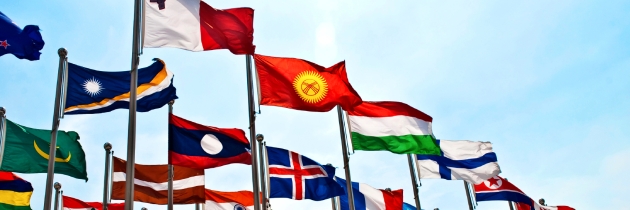Blogs

Our Solution for School Accountability Report Cards
As educators know, bare-bones budgets and reduced funding mean that California's schools have to do more with less, cut corners where they can, and make every last dollar count. As districts across California ready their systems and personnel to produce this school year's SARCs (School Accountability Report Cards), they must also consider the type of translation solutions they will need to accommodate the State's guidelines on disseminating information. When 15% or more of the pupils enrolled in a school speak a primary language other than English, it is required that schools provide the SARC in that primary language. When you partner with Avantpage, you are working with the best in the translation business. The quality of our translations is second to none, and our cost-effective menu of translation services offers affordable choices well within school budget constraints. We can translate into Spanish, Hmong, Tagalog, Vietnamese, Chinese, Korean, and over 150 other languages - swiftly, accurately and affordably. We understand the education market, and have a proven track record working with California education clients. In today's uncertain economic climate, it pays to do business with companies you can trust to do what they say they will, for the price they've quoted, in the time you've agreed upon. Avantpage has built a stellar reputation on mutual trust, high quality deliverables and exceptional customer service. Contact us today to find out how we can work together to produce the translation materials required to complete your SARC on time and within your budget.

Federal Health Care Reform — What Does it Mean for You?
In the wake of the recent federal health care regulations that went into effect on September 23rd, 2010, it's now more critical than ever to make sure that client health care information is distributed clearly and in a timely fashion. As more people become eligible for health care under the new laws, health care organizations and insurance providers will find that they are faced with greater challenges regarding language access. And as these reforms become part of our legal fabric, new and updated information must be prepared and distributed to everyone--proficient English speakers, non-English speakers and limited English speakers alike. How Can Avantpage help? Avantpage has highly qualified translation teams in place consisting of certified linguists who are trained specialists in threshold languages including Arabic, Armenian, Cambodian (Khmer), Chinese, Farsi, Hmong, Korean, Russian, Spanish, Tagalog and Vietnamese. We offer the most competitive pricing in the translation industry, and our AvantFlow online translation management system, experienced project managers, translation memory tools, and experienced linguistic teams ensure that our translation services consistently exceed industry standards and requirements. To meet increased workloads due to the health care regulations, Avantpage has recently ramped up our translation capacities, improved processing volume and timelines, and enhanced our quality control and service abilities. Whatever our clients' needs, we will deliver--swiftly, accurately and within budgetary constraints. Questions, confusion and misunderstandings are bound to be common offshoots of these sweeping regulatory changes. It's critical that you have procedures in place - including accurate, high-quality translation services -to help alleviate frustration and ensure that your clients understand the wording of these changes, how they will be affected, and the timing of all the different reforms. Written materials, websites and electronic correspondence must all be kept current, reflecting new information as it is made available by the government. We're Committed to Keeping You Informed Avantpage is scheduled to attend a number of important conferences that will address these latest issues. Please stop by and visit us at any of these conferences if you're available. We'd love to meet with you, and outline what we're doing to keep our clients informed of these critical developments in the health care field. We plan to report back with our impressions, observations and perspectives after these shows, so we will be in contact with you then.

Celebrate National Hispanic Heritage Month!
Did you know that from September 15th through October 15th, America celebrates National Hispanic Heritage Month? This observation began in 1968 as a celebratory week under President Lyndon B. Johnson, and was expanded by President Ronald Reagan in 1988 to cover a 30-day period. This month-long celebration marks a way for Americans to honor the contributions, culture and history of U.S. citizens whose ancestors hail from Spain, Mexico, the Caribbean, and Central and South America. September 15th was chosen as the start of this celebration because this date is the anniversary of independence for five Latin American countries: Costa Rica, El Salvador, Guatemala, Honduras and Nicaragua. In addition, Mexico declared its independence on September 16, and Chile on September 17. Throughout the country, people of Hispanic descent will be celebrating this year's theme: Heritage, Diversity, Integrity and Honor: The Renewed Hope of America (Herencia, Diversidad, Integridad y Honor: La Renovada Esperanza de America). Classrooms, museums, art galleries, government programs, and the media will offer a chance to explore Hispanic history, culture, art, literature, humanitarian contributions and more. The term Hispanic, as defined by the U.S. Census Bureau, refers to Spanish-speaking people in the United States of any race. On the 2000 Census form, more than 35 million people identified themselves as Hispanic or Latino. Population growth trends show that by 2050, Latino populations are expected nearly to triple. In California, the Hispanic population is expected to grow by 16.5 million people in the next 40 years. Read more about how Spanish translation can help you reach these prospective buyers in their own language, on their own terms, or call 877-ANY-LANG or email today!

Language Spotlight: Hmong
Where do different languages come from? Who speaks them? How are they unique? How do they change and evolve over time, becoming the "modern" languages spoken and written today? These are just some of the ideas we'll explore in our new blog topic: Language Spotlight. We've chosen Hmong as our first language, and if you have any suggestions for subsequent languages you'd like to see in the spotlight, please let us know! The Hmong ("mung") are an Asian tribal culture who have lived primarily in the countries of Laos, China, Vietnam and Thailand. After fighting for the United States in the Vietnam War, many Hmong were forced to flee their Southeast Asian homeland, and chose to settle in America to avoid oppression and persecution in Asia. There are approximately 200,000 Hmong living in the United States, and their numbers are concentrated in Minnesota, Michigan, Wisconsin and California. The total number of Hmong speakers worldwide is estimated to be about four million, including those in America. Did you know that for generations the Hmong had no written language? There were no written texts, no alphabet, and knowledge and culture were passed from generation to generation through spoken language only, often in the form of folktales and song. In the 1950s, Western missionaries worked with Hmong advisors to develop a way to write Hmong words using the letters from the French, English and German languages. This was called the Romanized Popular Alphabet, or RMA. The idea behind this was to be able to create a written Hmong language that used common Western letters, without having to rely on a lot of elaborate characters. Today, the RMA is the most widely used writing system for Hmong. The two major dialects spoken by Hmong Americans are known as White and Green. While mutually understandable, these two dialects differ somewhat in both lexicon and phonology. The Hmong language is monosyllabic, tonal, with a variety of dialects. Hmong shares some characteristics with several other Asian languages, including Chinese and Vietnamese. For information about Hmong translation, click here.

How Changing Demographics Affects Marketing Strategies: Are You Prepared?
Did you know that there is a vast pool of prospective buyers out there who you may be overlooking? According to research presented by The Hispanic Center,* the number of foreign-born United States citizens has increased significantly between the years 2000 and 2007. During this time, the number of foreign-born U.S. residents increased by 22.2%. In actual numbers, this translates to an increase of 6.9 million foreign-born individuals now residing in the United States. In total, there are over 38 million foreign-born residents, and 80 percent of these people were born in Latin America or Asia.** What does this type of demographic change mean for your business, your marketing strategies, and your ability to tap into lucrative new markets? The truth is, these folks have the purchasing power and the need for what you're selling. They're interested in your products and they're eager to buy ... but have you done everything you can to reach out and connect with them? Translating your product information, your advertising message and your marketing strategies into language these prospective buyers can understand and respond to gives you a clear-cut advantage over your competition. Although many of these individuals are proficient in English, reaching out to them in their native tongue shows that you are sensitive to their needs and respect their cultural differences. When you make the effort to translate information about your products and your business, you are taking the first step towards building powerful, long-term relationships with new foreign-born prospects. To find out more about how translation can help you reach these prospective buyers in their own languages, on their own terms, call 877-ANY-LANG or email today! We'll be happy to outline our translation services, offer suggestions for creating and maintaining a multicultural marketing presence, and help you take your marketing efforts to the next level. * Pew Hispanic Center tabulations of 2000 Census (5% IPUMS) and 2007 American Community Survey (1% IPUMS)

The 411 on Translation Memory
At Avantpage, we use glossaries and translation memory to save time in the long run, saving our clients money, as well as provide consistency within a translated document and among all your translated documents. Custom glossaries are built for each client, so that their preferences are recorded for future use. For example, if a client prefers the word "team member" instead of "employee," that's the word that will always be used. Using glossaries, any of our translators will be able to pick up material related to the same client, and have fewer questions about the way certain terms are to be translated. Working along the same lines, translation memory (TM) software helps us build on the previous work of our translators to save time in the future. Once a document has been completed and reviewed for quality assurance, it is converted to a TM file. When it's time to complete a new translation for the same client, we can analyze the new document against previously translated documents. The application helps decipher which words and phrases have been repeated and indicates how they were previously translated. Even though these technologies do not rely on computers to make the translation, they do make the translation process much more efficient by building on existing work. In the end, it's always an educated human translator that makes the final decision, as we strongly believe it should be.

Cross-Cultural Health Care: Caring in All Languages
Our friend, Carolyn Wang Kong, MPH, MPP, Practice Leader, Language Access, Northern California Diversity, Kaiser Permanente, will be participating in a noon-time panel presentation on September 24th at the Commonwealth Club of California. The topic of discussion is Cross-Cultural Health Care: Caring in All Languages. The event will address how doctors and patients can overcome the language barriers to enable and enhance access to health care. Come hear how technology is helping doctors and patients communicate through cyberspace. Kaiser Permanente Northern California has done excellent work in this area, and we're sure Carolyn Wang Kong and the rest of the panel will present an interesting and engaging hour. The event is underwritten by the California Wellness Foundation. For tickets, go to www.commonwealthclub.orgor call (415) 597-6705 . Location: The Commonwealth Club, San Francisco Club Office 595 Market Street, 2nd floor SF, CA 94105 Time: 11:30 a.m. check-in; Noon program Cost: MEMBERS FREE, $20 non-members, $7 students (with valid ID)

The Avantpage “Bridge” -- Why It Represents our Mission and Vision
At Avantpage, we're much more than just a translation company. We provide translation, localization, interpretation, language technology and much more - all with a unique sensitivity to other cultures, ethnic markets and foreign entities. Our documents and multimedia are not "just" translations - they feel and function as if they were produced in the target country. So, why the bridge? The image of the Avantpage bridge is elegant, yet powerful. Its grace and beauty belies an underlying strength that will provide safe passage to many future travelers. Our services provide a powerful bridge across which businesses can communicate, collaborate and function more effectively through many diverse languages. From localizing websites and online materials to the intricacies of international commerce, the Avantpage bridge of services reaches across language barriers and cultural differences, drawing people together and helping them to create lasting relationships with ethnic and foreign markets. Simply put, Avantpage represents a bridge to other cultures, a bridge towards more effective communication both locally and globally, and a bridge to a brighter future. Come and be a part of our journey as we travel across!

Avantpage's MBE Status: What Does That Mean, Exactly?
Are you aware that Avantpage is a minority-owned business? We are proud of our MBE status, and today I'd like to take just a moment to expand on that a bit ... What is an MBE? An MBE - Minority-owned Business Enterprise - is defined as a for-profit business which is owned, operated and controlled by minority group members who are Asian, Black, Hispanic or Native American. At least 51% of the business must be owned by a minority to qualify, or, if the business is publicly-owned, at least 51% of the stock must be owned by one or more members of a minority. Also, the management and day-to-day operations of the business must be controlled by minority group members as well. Many large corporations actively seek to do business with MBEs, and often have internal programs in place to contract services with a certain percentage of MBEs, in addition to their other suppliers. If you are interested in choosing a translation company with MBE status, Avantpage is certified by The National Minority Supplier Development Council (NMSDC). What does MBE status mean to our clients? There is actually a two-pronged advantage to Avantpage's MBE status. First, because we are certified as an MBE by the NMSDC, we are eligible to register with major corporations in their supplier diversity programs. And that means exciting opportunities for Avantpage to gain valuable experience with new corporate clients, improve our industry recognition, expand our services and grow as an organization. Secondly, there is a more "intangible" benefit to our being designated an MBE. In the translation industry, we deal closely with minority issues in regard to language barriers. We understand sensitive language issues, cultural differences, and diversity concerns, because our company was founded and built by minorities. Avantpage constantly seeks to further our understanding of and sensitivity to the needs and concerns of other minority businesses and individuals. While our MBE status is another advantage to working with us, our work stands by itself due to its quality, service and competitive cost.

What The World Cup Means to Your Business
Unless you've been traveling somewhere extremely remote where there's no radio, television, newspapers, magazines, podcasts, or Internet, you've no doubt seen - or heard - part of a FIFA World Cup soccer game from South Africa over the past four weeks.
It all wrapped up in the finale on Sunday, July 11 with Spain defeating the Netherlands for not just the European bragging rights, but for the world's title, too. So what does all of this World Cup frenzy mean to your business as it relates to using translations properly from Avantpage? As the world's greatest sports tournament, watched by an estimated 500 million TV viewers, being a football fan can be great for your company's business -- if you think globally to leverage the World Cup audience to your advantage. According to an Investopia article "World Cup: By The Numbers": On a broader scale, let's look at how companies are leveraging this gigantic global audience to drive more businesses and increase their bottom line. Sponsors: Traditional World Cup advertisers such as Adidas AG, Coca-Cola, McDonald's Corp., Hyundai, Kia, Sony, and Visa have historically benefitted from higher sales both during and following the tournament.
But for 2010, a few new relatively small enterprises launched their brands worldwide as sponsors. These included Yingli Green Energy Holding Company, a solar panel manufacturer that has a 7% share of the global solar energy market; Mahindra Satyam, an Indian IT services provider; and Seara, a Brazilian food supplier and the fourth largest meatpacking company worldwide.
Each of these newcomers was the first from their BRIC countries (Brazil-Russia-India-China) to sponsor the tournament and see a spike in awareness, which came after growth in their stock markets outpaced those of developed nations since the World Cup in 2006.
All of these advertisers could benefit from Avantpage's services for Globalization, Internationalization Localization, Transcreation and Translation for their websites, ads, and marketing communications. Musicians: Most radio and TV commercials for World Cup sponsors use music to pace the message and build their brand with mnemonic messages or jingles. These commercials are also more frequently being shown in movie theatres to different audiences. For songs, chants, and anthems downloaded by globally by soccer aficionados, the musicians could sell more singles and CDs via our Localization and Translation services. Social Networkers: If you're sending a Tweet through Twitter, writing on someone's Facebook wall, or uploading a YouTube video, it's important to speak their language so you can communicate most efficiently.
In terms of tweets, during this year's World Cup, a record was set during a Japan-Cameroon match on June 14 when tweets were sent at a rate of 2,940 per second about 30 seconds after the Japanese team scored the only goal of a 1-0 victory. And in the US-Slovenia World Cup match that ended in a draw, CNN's "South Africa 2010: Twitter Buzz" feature showed there were 174,078 tweets per minute near the end of the match, which translated to 2,901 tweets per second.
Both figures are nearly four times the average of Twitter's 750 tweets per second, which proves how big a hit Twitter has become in Japan since introducing a mobile version in October 2009. The Associated Press estimates that over 16% of Japanese Internet users tweet vs. 9.8% in the USA. It also proves that Twitter's traffic boost indicates how social media are driving the sports fan experience.
For social media, Avantpage can be the bridge advancing cross-cultural communication because of our ability to communicate in over 150 global languages. Our services for social media can include Globalization, Internationalization Localization, Transcreation, Translation and Transliteration. If you are interested in talking with us and learning more about how we can help your company expand and connect with new markets, please contact [email protected], or call 530-750-2024. Sources: SF Gate: World Cup: By the Numbers SF Gate: World Cup Investment Picks Offer One Sure Win SF Gate: Sports Fans Set Twitter Records

AltaMed Ranked #1 Hispanic Non-profit Corporation by Expenditures
Congratulations to our client, California-based AltaMed Health Services Corp.! HISPANIC BUSINESS Magazine has ranked it as the number one nonprofit in the nation based on spending in service to Hispanics. "Since 1969, the organization has provided health services to the underserved population in Los Angeles County, with special focus on the Mexican-American segment. Today it operates more than 20 facilities including five clinics, a youth center, and several HIV treatment centers. From prenatal testing to senior care, AltaMed has a program to address the need." Read more about their ranking, and how AltaMed helped pioneer the practice of bilingual and bicultural healthcare for the Hispanic market. We're glad to work with this great company as they strive to improve care and services for their members

Thoughts on Machine Translation
Being a technologist myself, I always look to the advances our scientists and engineers make with awe and wonder. As a society, we owe much to them. I also know better than to give absolutes like "Machine translation will never replace human translators". Human capacity and ingenuity knows no bounds as of yet. That said, we need to remember that as we apply machine translation to medical information, there are legal implications and, most importantly, the basis for medical choices and treatments. Mistakes and inaccuracies with medical information are simply not acceptable. In our medical translation workflow, the legitimate role we have for machine translation is for terminology research, and to see how others have translated text that is new for us. Please note that this is more than in the past, but still quite limited. Otherwise, because of legal, contractual and ethical requirements, we do not have or see any other role for machine translation in a medical context at this time. We will continue to follow the development of the technology, and as it evolves, evaluate how it can improve quality, lower costs and reduce turnaround time for our human translators. Luis Miguel, CEO tel: 530.750.2040, ext. 1